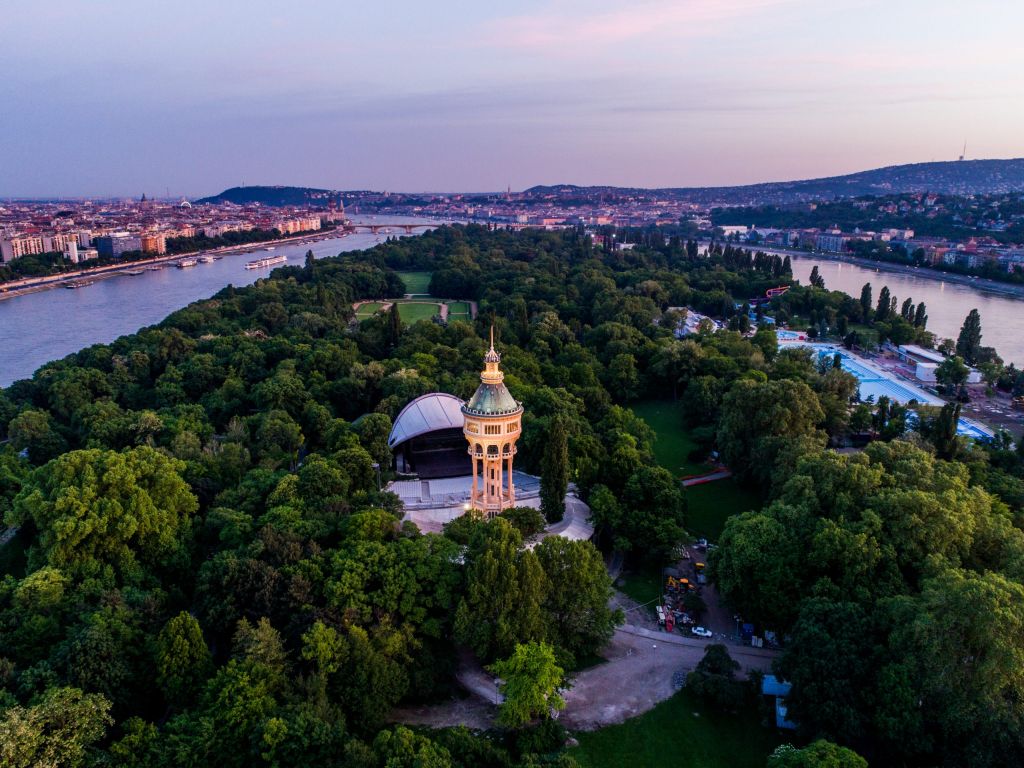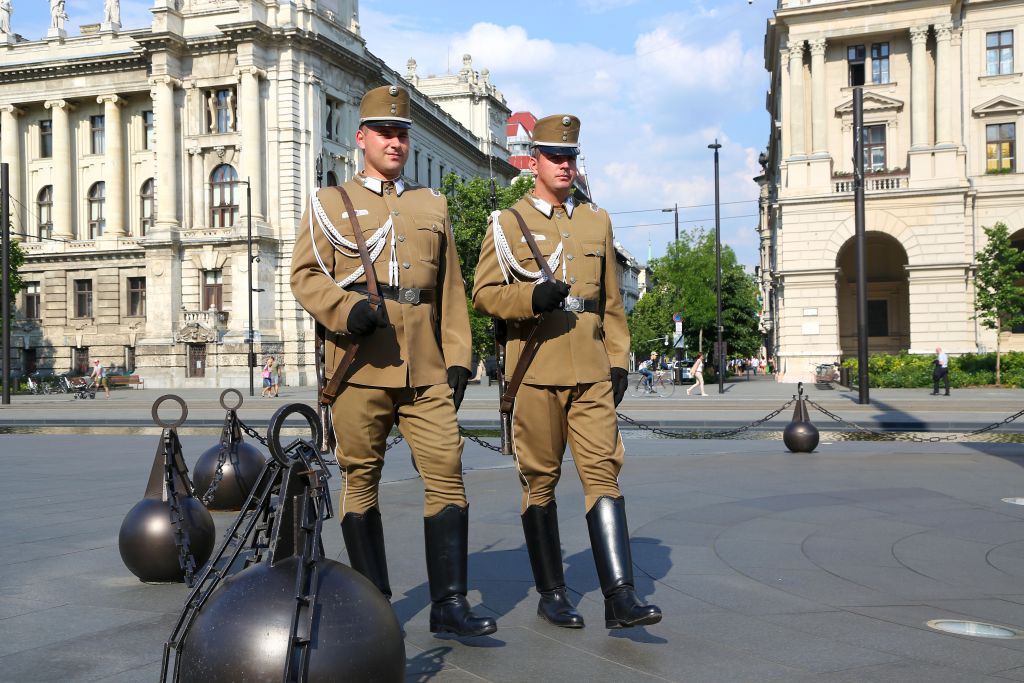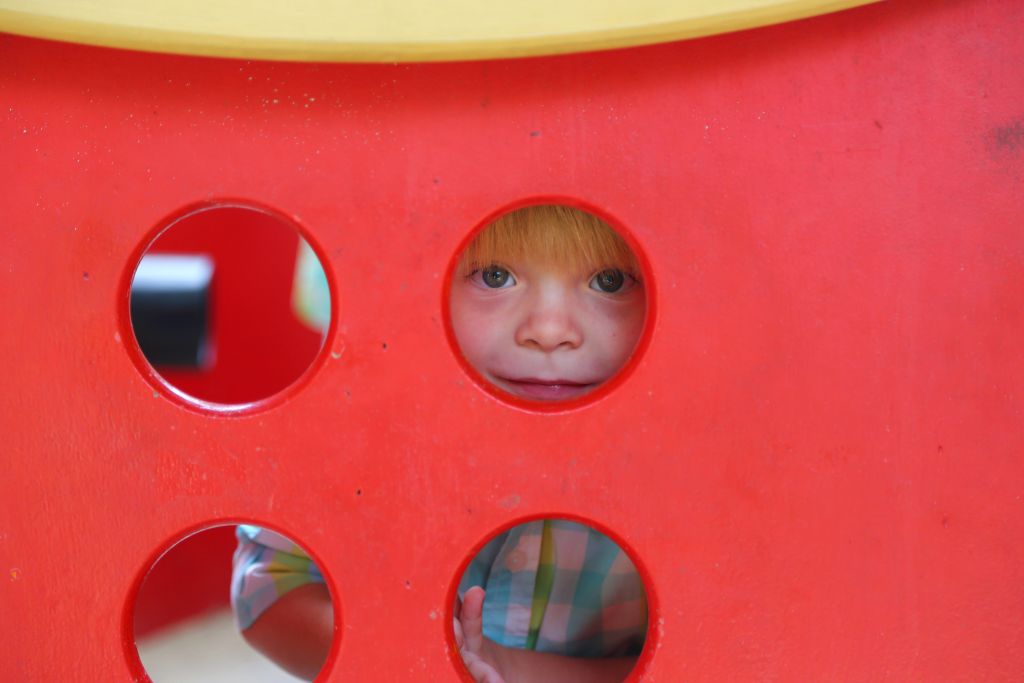Gellért Hill
Close to the two previous locations, there is the Gellért Hill. Its height is only 235 meters, and one can climb up it from any point – the paths running to the top are all around the hill.
Legend has it that the hill was named after a Catholic saint who preached Christianity. During the 11th-century revolt, the pagans put him in a barrel with nails and kicked him down the hill.

Today this place is particularly favored by tourists, and we could hardly believe that, up to the 18th century, vineyards and pastures were all that was located here.
In the 19th century, the Hungarians built the Citadella on the top of Gellért Hill. The location that they chose for this strong structure had its own purpose – it was the perfect place to observe and shell Buda and Pest. The length of the entire construction is 220 meters, and its height reaches 15 meters.
We saw chips and potholes on the walls in many places; they appeared here during the Second World War. At that time, the Soviet troops decided to seize the Citadella, which belonged then to German forces, by assault – they covertly came to the building at night and, after a long battle, destroyed the enemies.

As a tribute to this event, the Hungarians erected the 40-meter-long Liberty Statue near the Citadella – it is a woman holding a palm branch above her head.

This sculpture is seen from many locations in the city and initially showed gratitude to the Soviet troops. Nowadays, the statue is dedicated to all those who were killed in action for Hungarian independence.
The northwestern foot of the hill has a beautiful and calm place called the Garden of Philosophy. It is a small area with eight bronze sculptures. Five of them, placed around the miniature Earth, are the founders of the five world religions: Buddha, Akhenaten, Jesus Christ, Abraham, and Lao Tzu. Three other sculptures (Bodhidharma, Mahatma Gandhi, and Francis of Assisi) stand outside the circle.

200 meters from the garden, there is a statue of King Buda and Queen Pest. Buda and Pest, standing over the “abyss”, the Danube, hold out their hands to each other. The buildings behind the Queen’s back are slightly inclined, but this is for a reason – the sculptor wanted to show that the Pest part lies lower than the part of Buda.

On the opposite side of the hill, we met the Cave Church. It belongs to the Pauline Fathers, the only monastic order from Hungary.

It is curious that, during the Second World War, the monks often sheltered refugees here dressing them up in monk clothing. After the war was ended, however, the church was completely closed and neglected until 1990.

Robert and Michael also had fun in the hill area – there are two large playgrounds on the hill. One of them is a number of different slides – these are open, covered, flat, and steep slides. These are amusements that cater to every taste!
Another playground is designed in a very unusual style – almost all posts and crossbeams are shaped like colored pencils.
János Hill and Elizabeth Lookout
János Hill, located in the western part of Budapest, is the highest place in the city. Its height is as much as 528 meters.
The top of the hill is crowned with the Elizabeth Lookout of 23.5 meters high.

The structure attracts many tourists as its lookout opens picturesque panoramic views of the Hungarian capital and its suburbs in all their glory.

Until the 20th century, there was a small wooden platform instead of the tower. Majestic views, however, constantly tempted travelers; even Elizabeth of Bavaria took the chance to visit the hill. Therefore, at the beginning of the last century, the Hungarians erected the watchtower which later got the name of Empress.
Margaret Island
Margaret Island is a 2.5-kilometer park located in the very heart of the city. This island is a real heaven for leisure: a lot of sights and sports grounds, places for creating artworks, hotels, cafes, swimming pools, and baths.

Initially, it was called the Island of Rabbits. The legend has it that, during the Mongol-Tatar invasion, King Bela IV promised God to send his daughter Margaret to the monastery if the enemy was defeated. God did what he asked, and the king lived up to his promises. Thus, the girl spent her whole life in a Dominican monastery on the Island of Rabbits, which was later renamed in her honor.
To this day, only ruins have survived from the monastery, but we still managed to find Margaret’s grave, adorned with various flowers, among them.

Next to the ruins, there is the St. Michael’s Church, but, unlike the monastery, it was renovated in the 20th century. Archaeologists found a valuable architectural item here – a bell that has survived since the 15th century. It was installed in the church and is still used up to now.

Another island’s sight is the art-nouveau Water Tower that proudly stands over the green oasis. It was previously used to serve the island with thermal water and was the only reinforced concrete structure in the country.
But the island’s main highlight is the musical fountain. Sometimes it turns out to be the only reason why tourists visit Margaret Island, so we also decided not to miss this chance.
Every evening in summer, about 200 fountain jets go to the air with music. It is mostly classical music by such composers as Mozart, Strauss, or Vivaldi. But sometimes people can contemplate fountain “dancing” to hits by such rock singers as the Beatles, Chuck Berry, or the Rolling Stones.
Liberty Square
Another place of our visit was the Liberty Square. It evoked mixed feelings. On the one hand, today it is a beautiful and green place where Budapesters can relax from their busy urban life. On the other hand, its history is rather atrocious.

In the 19th century, there was nothing here but unpretentious barracks and prisons. In the middle of that century, the leaders of the Hungarian independence revolution were executed here, but later, all buildings were pulled down and this area began to gradually improve.
Nowadays, the square is surrounded by majestic historical buildings on three sides. One of these buildings is the Hungarian National Bank, the heart of the country’s finances, which was built at the beginning of the last century. This monumental development, designed with historical elements, is distinguished by its special low-key style.

Today, in the bank, tourists can visit a dedicated exhibition of forints (the Hungarian currency), as well as mint their own coin.
In front of the bank, there is the former Budapest Stock Exchange.

Curiously, both these buildings were designed by the same architect, Ignác Alpár. He applied Eastern and Greco-Roman motifs and decorated his works with statues, low-relief elements, and solid columns.
Many people considered the exchange building’s style too tortuous, but the bankers caught the fancy of it. Later, both the bank and the exchange houses were recognized as Alpár’s best works.
At some distance, there is a dark house with domes on its roof and plenty of sculptures of fabled beings.

This is the Adria Palace that was built in the early 20th century and formerly owned by a shipping company of the same name.
The company closed down a long time ago, but the building is still in use. One part of it is rented for shooting movies – here was partly shot “A Good Day to Die Hard”. Another part of the Adria Palace is filled with apartments.

In addition to luxury buildings, we saw many monuments on Liberty Square. Thus, near the palace, there is a life-size bronze monument to Ronald Reagan. In his day, the ex-president helped Hungary to become independent, so people here respectful him a lot.

Ironically, the monument to Reagan stands not far from the 14-meter Soviet Memorial, one of the few such monuments in Europe. It was erected in 1945 and has been the vandalistic target over the years.

But the most outstanding and remarkable monument here is perhaps the Memorial for Victims of the German Occupation. Since its unveiling in 2014, it has triggered many furious controversies and protests. The problem is that the memorial represents the archangel Gabriel (the symbol of affected Hungary) which is attacked by an eagle (the Nazis symbol). Many people, however, take issue with the author’s opinion.

All in all, Liberty Square was a great place to spend time with our boys. There is enough space to relax for both adults, to admire the survived architectural structures, and children – the square has two playgrounds where Robert and Michael had a lot of good time.
On weekends, the square becomes filled with booths that sell beers and snacks and up until very late into the night it’s crowded with people.
Hungarian Parliament Building
The Parliament Building (Palace) in Budapest is a landmark of the city and the whole country. This impressive structure is one of the largest parliamentary homes in Europe; it measures 268 meters in length and the number of rooms is close to 700!

The palace is located in Pest, a few meters from the Danubian bank, but we needed to cross the river to contemplate this magnificent architectural landmark in all its glory.

This large-scaling building began to be built in 1885 and was designed by the famous enthusiast Imre Steindl. The palace was planned to be finished in two years. However, these plans were quite not realistic, so the construction dragged on for 19 years and, by the target date, workers managed to finish only the central part of it, the dome hall. Despite the ongoing construction, already in 1886, the dome hall held the first parliamentary meeting.

As the main style, the architect chose Neogothic one and seamlessly added hints of French, English, and Oriental styles there. Interestingly that Imre Steindl did not manage to see his creation finished – he died just five weeks before the state opening of the building.
The Parliament Palace faces a small square with a Hungarian flag on the high flagpole in the center. Our boys were delighted to be photographed with the soldiers of the guard of honor and watched them pace during the changing.

Near the square, there is also a small fountain in which tourists often throw various coins during the day. In this hot weather, Michael and Robert had a lot of fun stomping around this fountain and collecting coins. They got a bunch of them, and we were then amused to examine the coins – they, large and small, came from all over the world.
Walking a few hundred meters north of the Parliament Building, we came to a small Olimpia Park. It was named after the memorial of the five Olympic Rings installed there.

This green place is a big draw for the locals as they can picnic on fresh grass here, relax in the shade of sprawling trees, and play basketball on a designated court. There is a special area for dog owners in the park where their four-legged friends can have a long playtime with their mates.
But most of all, we adored the park for its playground. Having visited dozens of similar places all over the city, we – and, of course, our boys – can justly call the playground in the Olimpia Park the best. Slides, various swings, multi-story structures for climbing… There are enough “amusements” to spend time with children for hours there.

Here, near the park, stringing out along the river, there is a long promenade. It is covered with many benches on which we could spend a long time contemplating the beauty of the wide Danube.
Walking 300 meters south along the promenade, we came to the famous memorial represented by 60 pairs of down-at-heel shoes. There we saw clunky men’s and little women’s shoes and even children’s slippers. From afar, it seems as if they were real shoes that someone had just left on the bank.

In fact, it is a monument dedicated to the Holocaust victims who died right here, in the Danube River. They were brought ashore, ordered to take off their shoes, and taken away on barges to later be shot and left in the river for good. Today, none of the city tours goes without mentioning this sad monument.






Leave A Comment